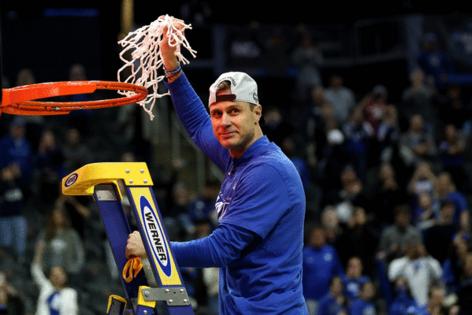Luke DeCock: As sixth grader, Duke coach Jon Scheyer took on the kind of challenge that now defines him
Published in Basketball
The Pat Beverley clip went viral last month, and quickly. He may be better known as a podcaster and former NBA player now, but at one point Beverley was a rival of Jon Scheyer on the Chicago basketball scene, and Beverley had a lot to say about the Duke basketball coach’s willingness to play anyone, anywhere.
Beverley grew up on the West Side and went to Marshall. Scheyer grew up in Northbrook, in the northern suburbs. When Beverley said people called Scheyer “The White Mike,” after Michael Jordan, his Duke players now said they could barely believe it.
But they should. They should.
“When I say he never ducked any smoke from any athlete in Chicago, he never ducked any smoke,” Beverley said. “If you’re from the West Side of Chicago, your high school is in the hood? ‘I’m on my way. I’m coming, I’m playing.’ If you were highly ranked, ranked closer to me, ‘It’s OK, I’m coming to play.’ Any Christmas tournament, Proviso West? Jon Scheyer, yeah the coach at Duke. ‘I’m on my way, I’m playing. I don’t give a (expletive) who y’all think y’all is.’
“They called him ‘the White Mike’. He was so cold, it was (expletives) in the projects walking to his games, you don’t hear what I’m saying, walking to his games at Proviso West. He had a stardom no other kid had in Chicago, and his school wasn’t even in Chicago. He was at Glenbrook North.”
Cooper Flagg, Duke’s freshman star, balked — “I don’t think anyone’s ever called him that,” Flagg said — and Scheyer acknowledges that the legend may have faded with time.
“They have completely disregarded the fact that I played at all,” Scheyer said. “They think that I did not play whatsoever.”
But it’s all true, and it started long before Scheyer was in high school, or at Duke.
Dudley Brown remembers.
Brown witnessed the beginning, when Scheyer was a sixth grader in a high-level league in another suburb, a world from the one where Scheyer grew up. Some 25 years later, Brown can still remember what crossed his mind the first time he saw Scheyer play.
“You just knew he was going to be a special player,” Brown said. “You could just watch him and tell, certainly. You just didn’t know how good he was going to be, but you knew he was going to be good.”
‘Wired to do what he’s doing’
Brown was, back then, the president of the Fellowship of Afro-American Men youth basketball league in the Chicago suburb of Evanston, a half-hour and a million miles from where Scheyer grew up in Northbrook. Scheyer’s experience playing FAAM, at first a sixth grade point guard on a team full of eighth graders, was perhaps the first documented evidence of two traits which defined Scheyer as a player and now as the head coach at Duke.
His willingness to go out of his comfort zone and play in a league that had become a magnet for the best middle-school players in the Chicago area was a marker of the adaptability that would define his entire career, whether it was being asked to play point guard late in his junior year at Duke, a move that laid the groundwork for the Blue Devils’ national title a year later, or pivoting to coaching at age 26 after the eye injury that effectively cut his playing career short.
Certainly, the way Scheyer followed his own path after taking over for perhaps the largest living personality in the sport has been a continuation of that, and there’s no question his rebuilding of this Duke roster around Flagg after last year’s NCAA Tournament disappointment showed tremendous flexibility.
But as Duke heads to San Antonio for the Final Four, he has also surprised people with his success, even those closest to him. He has been confounding expectations for three decades, first at FAAM as the skinny little kid with game, as “The White Mike” in high school, and unquestionably at Duke, where he was originally pigeonholed as a shooter and exited a versatile offensive and defensive player who was key to a championship.
And then as the coach in the unenviable position of taking over for a giant, who now has as many Final Four appearances in his first three years as Mike Krzyzewski had in his last six, and is two wins from a championship.
“Jon’s success does not surprise me,” said Bob Reece, his FAAM coach for three years. “Not at all. He was always wired to do what he’s doing.”
It all started in a community center in Evanston, Ill., where Scheyer first tested himself on Reece’s team against bigger, stronger, older, unfamiliar kids in what can be a hostile environment, but one that will embrace outsiders that prove themselves worthy. It all started on the Sonics.
Bedrock of a community
To understand FAAM, first you have to understand Evanston, pinned between the north border of Chicago and the affluent North Shore, home to a major research university, a city of 80,000 in its own right, as ethnically and economically diverse as the metropolis to the south.
Despite its extravagant wealth in some areas, especially along Lake Michigan, other areas were redlined into de facto segregation, isolated from prosperity. (Evanston recently became the first city in the country to offer reparations.) But the Black community in Evanston has a long history of looking out for itself when others wouldn’t, with strong support organizations and determined leaders with deep roots in the city.
FAAM is one of the strongest, founded in 1968 when the school district cut middle-school sports. A group of important community icons, including the city’s first Black police chief, were concerned about the lack of opportunity. They designed FAAM to go farther than the programs it replaced, incorporating academics and leadership into a winter-long basketball league.
Coaches, many of whom played college basketball, often coach the same team — all named after NBA teams — for decades. Multiple generations of families have passed through the league, and many alumni are among the crowds that still show up on Saturday mornings to watch the kids play basketball at Fleetwood-Jourdain on Foster Street and go to the pancake breakfast in February, the league’s biggest fund-raiser.
It became, and remains, an Evanston institution, a basketball oasis for young teens that filled a void at a time when the modern AAU/travel basketball culture was still developing, and now offers a healthier alternative to it. All these years later, players still have to turn in reports from their teachers and show up for tutoring if their grades aren’t good enough. If you miss practice on Friday, you don’t start Saturday.
The quality of basketball attracted white kids within Evanston by the ‘80s, and players of all kinds from all over Chicagoland in the ‘90s. By the time Scheyer came of age, there was a robust girls program and a cheerleading program, and the league had players from Chicago itself as well as far-flung suburbs.
“You had a bunch of guys who were exposed to higher levels of basketball, but our main purpose was really to provide positive male role models for primarily African-American male youth,” Brown said. “Then we expanded it to females. Then we said it’s for any kid who wants to play.”
‘Sense of family’
The father of an older player recommended playing FAAM to Scheyer’s father Jim when Jon was in fifth grade. Just as he would later in high school and college, sixth grade Scheyer wanted to go up against the best.
“For me, I take a lot of pride in the city of Chicago,” Jon Scheyer said. “Wherever there was a game, I’d go there to play.”
Jim Scheyer was also advised to try to get his son onto the team coached by Reece, an insurance executive and philanthropist as well as a longtime FAAM coach. Reece only had to be lightly convinced to use his first-round pick to draft Scheyer onto his Sonics, a perennial juggernaut whose players were the only ones in the league required to wear ties to games on Saturday mornings.
“This was a predominantly African-American team, but Jonathan, they accepted this white kid from Northbrook,” Reece said. “As a sixth grader, he was the point guard on a championship team comprised of mostly eighth graders.”
As Thomas Nute, one of those eighth graders, told the News & Observer in 2022: “Coach picks this white kid — no one knew who this kid was, at all, and then Coach is like, yeah, he’s going to be our starter. And we were like, ‘What!?’ ”
At the conclusion of that first title-winning season, Scheyer’s teammates assured him he would win the FAAM award for best newcomer. But Evanston is parochial at heart, a consequence of being so close to Chicago and the North Shore and not really being a part of either. Those borders not only matter, they help pull a diverse community together within them. Evanston Township High School’s rivalries with New Trier, to the north, and Loyola Academy, the closest Catholic school, are fierce in every sport.
Scheyer probably never stood a chance, whether he should have won or not. In the event, he was crushed when the award went to someone else at the annual banquet. Late that night, Jim Scheyer answered the door in Northbrook. The rest of the team was outside to cheer Jon up. A group of parents had driven them all the way out there to see him, and the kids stuck around until early in the morning.
“They just wanted to commiserate: You deserved it but didn’t get it,” Jim Scheyer said. “We remember the show of empathy and sense of family far more now than we would if he had gotten the award back then. That’s what it was like.”
‘It was a special time’
Years later, another kid from the north suburbs, Blake Peters, would be so enamored of his FAAM experience that his family moved to Evanston so he could play with his FAAM teammates at the high school. He’s now a senior at Princeton, having helped the Tigers to the Sweet 16 last year. His younger brother helped Evanston to the state semifinals this season.
Those kinds of moves are more common now than they were when Scheyer was 14. He stayed in Northbrook and played at Glenbrook North, where he beat out Derrick Rose to be Illinois’ Mr. Basketball as a senior. He was the first player from the northern suburbs to win Mr. Basketball since future Duke star Chris Collins, also at Glenbrook North, and the last until Stevenson’s Jalen Brunson. But his days in FAAM had an impact that lingers.
“Just a great experience with coach Reece and that (first) team in particular, with the eighth graders,” Jim Scheyer said. “Just some of the best relationships Jon’s formed in basketball. Those kids, they treated him like a younger brother, and they could be rough with him, but nobody else could. It was a special time.”
Reece attended Scheyer’s wedding, will be watching Duke in San Antonio, and for many years would get a text from Scheyer on Thanksgiving. He once mentioned it to Scheyer’s father, figuring there was a list of old coaches who he texted on the holiday. No, he was told, just you.
“He’s an incredible, incredible human being, both on the court and off the court,” Reece said. “He’s told me so many times, his experience in FAAM not only changed his life but the life of his family as well. He had a sister that went to the University of Michigan. She had written a term paper about the family’s experience in FAAM and how it changed their lives.”
It’s true: Scheyer’s younger sister Jenifer wrote a term paper about her brother’s time in FAAM.
Old habits, new era
While that was a long time ago, it’s easy to see how all of it still echoes. Is it a straight line from being the skinny outsider who finds a way to win over his older teammates to the coach who texts his team late at night, unprovoked, with random messages? Maybe not. But it’s not far off.
“He texts the team at, like, 11,” Duke guard Kon Knueppel said in Newark, N.J. “Before this trip, before we left, it was like, ‘I want us thinking about how we’re just going to outrebound Arizona’ or whatever, something like that.”
There are formative experiences that reveal character traits, and those that hone them. The flexibility and confidence that Scheyer had first as a player and now as a coach, the keys to his success, were always there.
Everything that defines him at Duke was present then, if embryonic. The courage to have tough conversations with players on last year’s team that led to their departures or, in Tyrese Proctor’s case, his recommitment to the effort. The willingness to play anyone, anywhere that led to early season losses to Kentucky and Kansas, but gave this team the hard-earned experience of winning at Arizona and the confidence boost of a late-season drubbing of Illinois.
And more than that, the confidence to take what may have been the most difficult job in basketball, as Krzyzewski’s successor, and made it look easy. Scheyer defied expectations as a sixth grader, he defied them as a player and he’s defying them as a coach. What started at Fleetwood-Jourdain helped him win a national championship as a player, and has him within two games of one as a coach.
“He was willing to put himself in different situations and always believed in himself and was comfortable with that,” Jim Scheyer said. “He also had a great respect for other people that were talented, too. He was willing to test his limits or whatever limits just to be the best he could be. He was willing to go anywhere, anytime, whatever the experience was, and Evanston was part of that.”
It still is. Brown, the former FAAM president, had a son who played FAAM, growing up in Evanston, three years older than Scheyer. As a freshman, Jon Scheyer’s Glenbrook North team beat Austin Brown’s Evanston team in the state third-place game.
Austin Brown is now the top basketball agent at Creative Artists Agency. His newest, hottest client is Cooper Flagg.
©2025 The News & Observer. Visit at newsobserver.com. Distributed at Tribune Content Agency, LLC.







Comments